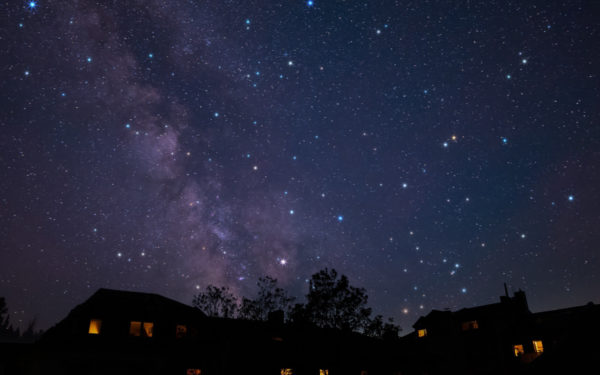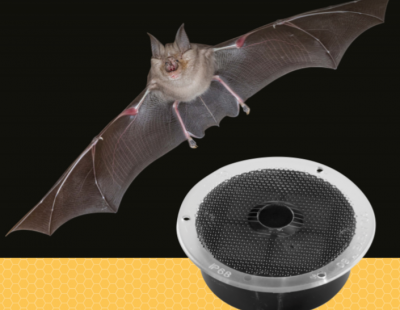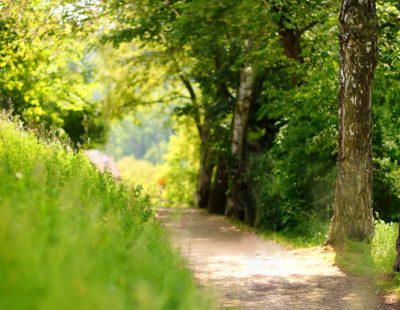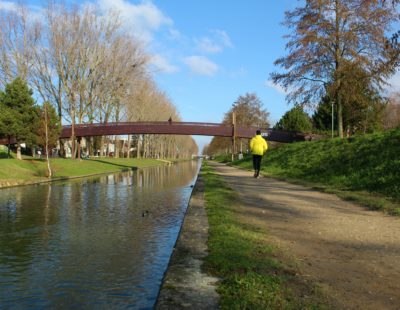Spring marks the emergence of UK bats from their hibernation roosts. As the days grow warmer, bats will begin hunting for insects during the night, and early summer will see females gathering in maternity roosts to give birth and raise young. The health of bat populations is indicative of wider biodiversity and bats can even act as pest controllers. By understanding more about these incredible animals and our impact on them, we can move towards a world where wildlife and humans thrive.
Solareye is a family-owned company dedicated to creating high-performing, durable, and ecologically sensitive outdoor lights. Our Bat Hat was designed in conversation with the Bat Conservation Trust, and boasts a 98% reduction in upwards light spillage!
In this article, we answer some of your bat FAQs and provide guidance on creating outdoor lighting schemes with bats in mind.
Where do bats live?
During the day, bats rest in roosts. The roosting conditions required by different species may vary throughout the year. For example, during the summer, female bats gather in maternity roosts to give birth and raise their young. In the winter, bats need roosts that provide the right conditions and protect them during hibernation. The most common types of roosts include trees, underground sites, bat boxes, built structures, roofs, gaps in walls. When bats emerge from their roosts at night to feed, they do so on a variety of different insects, meaning they can be found in a variety of habitats too. These can include wetlands, woodlands, farmland, and also urban environments.
The Importance of Bats in Our Towns and Cities >
Are bats nocturnal?
Whilst some bats hunt in the day, all UK species of bats are nocturnal. That means they are active during the night, and sleep during the day. Typically, a bat will emerge from its roost around 20 minutes after sunset to hunt. Dusk is peak feeding time as most insects are active then too. Using echolocation, bats are able to navigate effectively whilst facing reduced predation under the cover of darkness.
How do bats navigate?
Bats do have eyes that function well during dusk, but they primarily navigate using echolocation. Here’s how it works.
Depending on the species, the bat will make a high-pitched sound by pushing air past their vocal chords and out through their mouth or nose. Scientists don’t fully understand how bats produce sound, but it is thought that their complex nose structure helps them direct and channel soundwaves towards different targets.
If the soundwaves meet an object, they will be reflected back to the bat. Listening carefully, the bat will be able to glean important information from this echo relating to the object’s distance, size, position, and even texture. A smaller object will have a lower sound echo than a larger object. Using this information, they will be able to create highly accurate sound landscapes and navigate effectively in the dark.
Echolocation is also vital during hunting. For example, if an insect is moving away, the echo will have a lower pitch than if the insect is moving towards the bat. Moreover, if the insect is to one side of the bat, it will receive a higher pitch of echo in one ear than the other. A bat’s ears have complex folds that enable it to interpret the echo and exactly determine the position of insects so they can catch them mid-flight.
What do bats eat?
As previously mentioned, many bats are insectivores, and all of the UK’s 18 bat species are entirely so. Bats eat a wide variety of insect species, including beetles, moths, mosquitoes, mayfly, lacewings, and caddis flies. They feed by flying around 2-10 metres above the ground, echolocating and catching insects on the wing using a technique is known as aerial hawking.
A single pipistrelle (which weighs less than a 2p coin!) will consume up to 3,000 insects in just one night. Their dependency on insects means bats are intimately connected to the biodiversity and health of an ecosystem – they are what is known as an ‘indicator species’.
Do bats hibernate?
As the temperature begins to fall in the autumn, UK bats will be on the lookout for a warm, sheltered roost to hibernate in. They will enter hibernation around November and remain in this state of deep sleep or torpor for around 6 months. During this time, their body temperature will drop, and their metabolic rate will slow, enabling them to eke out their fat reserves. Whilst a bat in flight can have a heart rate of 1,000 beats per minute, a hibernating bat’s heart will slow right down – beating only a few times per minute.
When do bats come out of hibernation?
In the UK, bats typically come out of hibernation in April and will be fully active by May. After 6 months of hibernation, they will be extremely hungry and highly active on mild nights as they replenish their depleted energy reserves. During this time of year, though, any cold weather, high winds, or heavy rainfall can lead them to become torpid again until conditions improve. At this time, they may also start varying their roost, feeding all night and returning to the closest, most suitable option at dawn.
Are bats protected?
Bats are legally protected in the UK and abroad. The following actions are considered criminal offences under the Wildlife and Countryside Act (1981) and the Conservation of Habitats and Species Regulations (2017).
- – Deliberately taking, injuring, or killing a wild bat.
- – Intentionally or recklessly disturbing a bat in its roost or deliberately disturbing a group of bats.
- – Damaging or destroying a roost, even if the bats are not occupying it at the time.
- – Possessing, advertising, selling, or exchanging a wild bat (dead or alive) or any part of a bat.
- – Intentionally or recklessly obstructing access to a roost (not necessarily physically; improper artificial lighting, for example, can also restrict access and exit).
How do lights affect bats?
Artificial Lighting at Night (ALAN) has a detrimental impact on a wide range of nocturnal animals, and bats are no exception. Lighting near a bat roost can cause disturbance – during the winter months, the bats may starve if they do not find a suitable alternative hibernation roost quickly.
Lighting continues to be a threat throughout the year, though, prompting light-averse bats to desert their roost (and potentially their young) or instead causing them to become entombed within it and unable to feed.
Even light that delays their emergence can have devastating consequences on bat populations, as crepuscular times of day like dusk and dawn are when most insects are active. Missing out on this peak feeding time can therefore affect growth rates and reproductive success.
More than that, because lights attract many types of nocturnal insects, outdoor lighting can create what is known as the ‘vacuum effect’. This impacts slow-flying bat species in particular as they tend to be the most light-averse. Whilst these species favour foraging grounds with low-light levels due to reduced risk of predation, their prey will be drawn to adjacent, illuminated ones. ALAN can also sever flight paths and commuting routes between foraging grounds and roosts.
At Solareye, we’re passionate about helping businesses and local authorities create safe, comfortable, and enjoyable outdoor spaces, but we don’t want this to come at the expense of wildlife. That’s why we designed our Bat Hat device, which reduces upwards light spillage by 98%! Post-installation monitoring by a local bat group and county council indicated a modest but positive trend in numbers with winter numbers within the nearby roost increased in the following three years of post-installation monitoring.
Bats & Artificial Lighting At Night (ALAN) guidelines
When lighting an area, it is important to first consider the species that might be present, the way they use the habitat (e.g., roosting, foraging), existing light levels, and indirect effects (e.g., disturbing trophic interactions). The detrimental impact ALAN can have on bats and other nocturnal species means it is important to observe the recommendations found here, here, and here. These guidelines largely propose a hierarchy of strategies to take in order of preference: avoidance, mitigation, and compensation.
Avoidance
ALAN should be avoided as much as possible, with outdoor lighting only installed in situations where it is necessary for safety reasons or to comply with legal regulations. This can also include planning new infrastructure to avoid bat habitats and creating dark refuges that protect bats without putting human safety at risk.
Mitigation
Mitigation refers to the way in which ALAN is implemented. Outdoor lighting schemes should limit the impact of ALAN by:
- – Arranging lights to enhance dark refuges.
- – Limiting the duration of illumination to when is strictly necessary.
- – Reducing light trespass using precise directionality.
- – Reducing the illuminance of light sources.
- – Adapting the spectral composition of light sources to the ecological context (warmer colour temperatures tend to be less disruptive, though this can vary between species).
Compensation
New outdoor lighting projects should take an approach known as ‘No Net Loss of Darkness’ to help limit the yearly increase in night sky brightness. Under this principle, any feeding areas and commuting routes impacted your lighting scheme should be quantified and the same amount restored in alternative areas. These alternative areas need to be near the project in question to ensure impacted bats can benefit.
What is Eco-Friendly Lighting? Everything You Need to Know >
Bat-friendly outdoor solar lighting
If you’re looking to light your outdoor space without harming local ecosystems, Solareye can help. Our Bat Hat can reduce light trespass into ecologically sensitive areas and preserve dark spaces for bats. We also offer our LED solar lights in warm-white, a colour temperature recommended by the International Dark Sky Association for new outdoor lighting to reduce the impact on the feeding patterns of nocturnal wildlife.
Talk to us for further advice!
Read next: Ecological Considerations for Pathway Lighting
Read next: Understanding the Best Options for Public Outdoor Lighting





